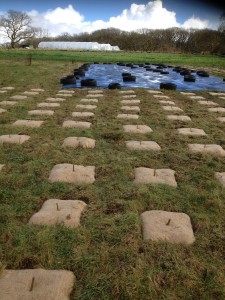
We ran two training days this & last week with West Wales Willows. During these workshops we explored building fertility on the land through growing green manure crops & short rotation willow coppice.
The basic idea is to work towards becoming self sufficient in growing the fertility that feeds our soils & thereby our crops & eventually us! We also have some really wet ground that we wanted to make use of.
Currently we rely on a mixture of some green manure crops, plus whatever manures & composts we can bring in from locals farms. There is always a risk not knowing what weeds or possibly even chemicals come into our soils with this imported material.
In the long term we would like to grow all of our own fertility through;
- Green manure crops such as;
- Phacelia
- Mustards
- Clovers
- Cereals
- Vetch etc
- Short rotation Willow Coppice
- This will be chipped after harvest & the chips applied to the areas of green manures. They will be building soil carbon & increasing soil biological activity.
We currently grow a range of green manure crops, but given the new land at Furzehill, we now have the ability to open out our rotation & account for growing our own fertility too.
We have planted 400 willow cuttings this week through plastic, biodegradable mats & a small section just mulched with woodchip. West Wales Willow generally use plastic sheeting. This can be removed after the willow is established & recycled. However, it is plastic, it reduces biodiversity around the coppice area & looks ugly whilst its there. So we decided to try half of the planting through biodegradable mulch mat. We’ll see how the willow compare in the coming years.
Managing the willow
- We will cut the willow back next year & select a few main stems from each cutting. (Next years cuttings will be planted to double our willow area. We’ll d this every year til we have about an acre).
- We will then strip the majority of buds so that its energy goes into producing long poles.
- After 3 to 5 years we will cut & chip these long poles. The chip will go onto the green manure crops. We are exploring if this will first be composted or not.
- The cycle starts again. This way we cut & chip a different area every 3 to 5 years, returning to our original plot once that has re grown.
- After 30 years the willow will be pretty tired, so it may be replaced with new willows or become habitat.
